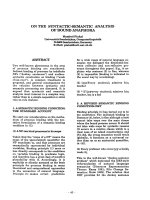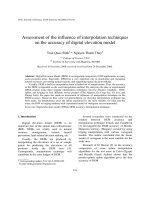DEC Is Dead-Long Live DEC: THE LASTING LEGACY OF DIGITAL EQUIPMENT CORPORATION pot
Bạn đang xem bản rút gọn của tài liệu. Xem và tải ngay bản đầy đủ của tài liệu tại đây (2.05 MB, 337 trang )
DEC Is Dead, Long Live DEC
This page intentionally left blank
Long Live DEC
THE LASTING LEGACY
OF DIGITAL EQUIPMENT CORPORATION
Edgar H. Schein
with Peter DeLisi, Paul Kampas,
and Michael Sonduck
DEC Is Dead
DEC Is Dead, Long Live DEC
Copyright © 2003, 2004 by Edgar H. Schein
All rights reserved. No part of this publication may be reproduced, distributed, or trans-
mitted in any form or by any means, including photocopying, recording, or other electron-
ic or mechanical methods, without the prior written permission of the publisher, except in
the case of brief quotations embodied in critical reviews and certain other noncommercial
uses permitted by copyright law. For permission requests, write to the publisher,
addressed “Attention: Permissions Coordinator,” at the address below.
Berrett-Koehler Publishers, Inc.
235 Montgomery Street, Suite 650
San Francisco, California 94104-2916
Tel: (415) 288-0260, Fax: (415) 362-2512
www.bkconnection.com
Ordering information for print editions
Quantity sales. Special discounts are available on quantity purchases by corporations,
associations, and others. For details, contact the “Special Sales Department” at the
Berrett-Koehler address above.
Individual sales. Berrett-Koehler publications are available through most bookstores. They
can also be ordered directly from Berrett-Koehler: Tel: (800) 929-2929; Fax: (802) 864-
7626; www.bkconnection.com
Orders for college textbook/course adoption use. Please contact Berrett-Koehler:
Tel: (800) 929-2929; Fax: (802) 864-7626.
Orders by U.S. trade bookstores and wholesalers. Please contact Ingram Publisher
Services, Tel: (800) 509-4887; Fax: (800) 838-1149; E-mail: customer.service@ingram
publisherservices.com; or visit www.ingrampublisherservices.com/Ordering for details
about electronic ordering.
Berrett-Koehler and the BK logo are registered trademarks of Berrett-Koehler
Publishers, Inc.
First Edition
Hardcover print edition ISBN 978-1-57675-225-8
Paperback print edition ISBN 978-1-57675-305-7
PDF e-book ISBN 978-1-60509-408-3
2009-1
Project management, design, and composition: BookMatters, Berkeley;
Copyedit: Mike Mollett; Proofreading: Janet Reed Blake; Index: Ken DellaPenta.
Cover design: Ark Stein, The Visual Group.
List of Illustrations vii
Preface ix
Acknowledgments xiii
1. Purpose and Overview 1
2. Three Developmental Streams: A Model
for Deciphering the Lessons of the DEC Story 16
THE CREATION OF A CULTURE OF INNOVATION:
THE TECHNOLOGY, ORGANIZATION,
AND CULTURE STREAMS ARE ONE AND THE SAME
29
3. Ken Olsen, the Scientist-Engineer 33
4. Ken Olsen, the Leader and Manager 47
5. Ken Olsen, the Salesman-Marketer 71
6. DEC’s Cultural Paradigm 80
7. DEC’s “Other” Legacy: The Development of Leaders 90
Tracy C. Gibbons
8. DEC’s Impact on the Evolution
of Organization Development 113
Contents
part one
THE STREAMS DIVERGE, CAUSING
AN ORGANIZATIONAL MIDLIFE CRISIS
125
9. The Impact of Changing Technology 131
Paul Kampas
10. The Impact of Success, Growth, and Age 146
11. Learning Efforts Reveal Cultural Strengths and Rigidities 168
12. The Turbulent 1980s: Peaking but Weakening 195
13. The Beginning of the End:
Ken Olsen’s Final Efforts to Save DEC 222
LESSONS AND LEGACIES 239
14. Obvious Lessons and Subtle Lessons 243
15. The Lasting Legacy of Digital Equipment Corporation 255
Appendixes
A. DEC’s Technical Legacy 269
B. DEC Manufacturing:
Contributions Made and Lessons Learned 273
Michael Sonduck
C. DEC, the First Knowledge Organization 280
A 1991 Memo by Debra Rogers Amidon
D. Digital: The Strategic Failure 283
Peter DeLisi
E. What Happened? A Postscript 292
Gordon Bell
References 303
Index 307
About the Author 319
vi
CONTENTS
part two
part three
FIGURES
2.1. Three Levels of Culture 21
6.1. DEC’s Cultural Paradigm: Part 1 82
6.2. DEC’s Cultural Paradigm: Part 2 83
7.1. Parody of a DEC Employment Ad 98
9.1. The Three Paradigms of the Computer Revolution 133
9.2. The Development of DEC into
a Full-Solution Company by the Mid-1970s 136
9.3. Anatomy of a Technology Wave 137
9.4. The Dramatic Shift in Innovation Mix as a
Technology Matures 138
9.5. The Emergence of the Category Killers 140
E.1. 1975 Graph Showing the Decline in Price
of Computers, 1966–1986 294
E.2. 1981 Graph Showing the Performance
for Semiconductor and Processor Architectures
in the Minicomputer Class 295
TABLES
7.1. Attributes of Transformational Leaders and Managers 93
9.1. Characteristics of the Three Paradigms
and the Shifts between Them 142
vii
Illustrations
This page intentionally left blank
My collaborating authors and I have, from the very beginning of this
project, struggled with the question of who is our audience and who
might benefit from the lessons that one can glean from such a story of
one company. We have identified many possible audiences—founders
and entrepreneurs; investors; executives who are trying to change their
companies to become more innovative, or perhaps more efficient and
less innovative; management theorists interested in the growth, evo-
lution, and death of an organization; organizational consultants; stu-
dents going into business and wondering what sort of a world they
might be entering; professors interested in teaching about leadership,
organizational culture, and technology; and, of course, Digital
Equipment Corportion (DEC) alumni, many of whom are still won-
dering what happened and why.
My own answer to the question of audience is that we are writing
to the thinking and reflective person in all of the above categories. Too
many of our business books just focus on what to do. They make glib
assumptions about a situation that an organization might face and
propose a few action steps to solve the problem. The DEC story should
make you think and reflect and make you aware of the tough choices
ix
Preface
and trade-offs that have to be made in the real world all the time. The
DEC story illustrates that every company’s evolution is unique but
that certain kinds of events are universal because they derive from the
inevitable consequences of success, growth, and age. What DEC
should have done, what another company in the same situation
should or might have done, what you should do in your unique orga-
nizational situation requires some deep thought and insight into the
dynamics of organizational evolution.
As I hope the reader will see, the implementation of even the sim-
plest prescriptions like “Have a strategy,” something all management
books agree on, becomes quite complex in the context of a particular
company, with a particular history, and with particular personalities
that create a certain kind of culture.
My contributing authors and I have had many arguments about
what are the “lessons” to be learned from the DEC story about gover-
nance, leadership, entrepreneurship, technology, innovation, strategy,
marketing and, perhaps most important, organizational culture. What
makes the DEC story both so interesting and so complicated is that
there are lessons to be learned about all of these things, but they don’t
fall out nicely into ten principles, or five things to avoid, or seven steps
to business success.
One of our interviewees who spent most of his career within DEC
kept reminding me that “DEC was a coat of many colors, so don’t try
to write a simple one-dimensional history of it. It won’t work.” He was,
of course, correct, and we found this out the hard way in our own dis-
cussions of how to write this book because each of us saw DEC from
our own perspective, drew our own lessons, and our his own biases in
how the story should be told. We tried to integrate these points of
view, but just as DEC failed at many levels to integrate the agendas of
its various subgroups, so we also failed in this task and have, therefore,
a story that is itself also a coat of many colors.
This preface is written in the first person because I felt that ulti-
mately my outsider perspective and my interest in organizational cul-
ture and leadership added a dimension to the analysis that is missing
in most books about organizations and management. I have tried to
x
PREFACE
learn from my supporting authors and have encouraged them to write
their own views to be included wherever possible, but in the end I tried
to write what seemed to me to be the aspects of the story that are typ-
ically not told by insiders, either because they are not of interest to
them or because, by being insiders, they cannot see their own culture
sufficiently clearly to understand its power and ubiquitousness.
So we have here a book about culture and leadership, a book about
technology, innovation, organizational success, and failure. The DEC
story is to me a story of how technology, organizational growth, and
business functions such as strategy, marketing, and finance not only
interact with one another but are deeply colored by the cultural
forces that are at play in the organization. To grasp this interplay re-
quires something from the reader—some thought and reflection. The
lessons are there for all the audiences mentioned above, and we try to
bring them out as clearly as possible, but none of these lessons are sim-
ple because, in the end, real organizations founded and run by real
people are not simple. This book is an attempt to pay tribute to those
real people who were solving difficult real problems and to identify
how their efforts left an important legacy.
Edgar H. Schein
May 2003
PREFACE
xi
This page intentionally left blank
My collaborating authors, Peter DeLisi, Paul Kampas, and Michael
Sonduck, not only contributed directly to various chapters of this
book but were also invaluable in helping me to think through how to
tell the DEC story. They each had different experiences and different
biases but our long discussions and exchanges of phone calls and
e-mails gradually enabled me to think through how best to tell the
story. The Sloan School of Management’s research committee gener-
ously supported this three-year project, and my colleague John Van
Maanen provided helpful comments on the final manuscript.
My most heartfelt thanks go to Ken Olsen, the founder of Digital
Equipment Corporation. Not only did his willingness to keep me
around as a consultant for thirty years enable me to perceive what was
going on in DEC in a way that most outsiders never have a chance to
see, but his support for this book was unflagging. He has spent many
hours in the past couple of years giving me his thoughts on what hap-
pened and why, sent me many documents, and encouraged me to re-
veal to the world how his vision of science and technology created a
unique kind of organization and culture.
I am also greatly indebted to Rod Sutherland, who turned over to
xiii
Acknowledgments
me twenty years worth of DEC reports, management memos, and
other materials that he had accumulated in his marketing role. I sent
out general inquiries through the DEC Alumni Association and thank
them for helping me to locate many of my informants. Gordon Bell
was particularly helpful in structuring the technical side of this story
and in providing his “final words” on what he thinks really happened.
I am also especially grateful to Tracy Gibbons for offering to write a
chapter on how DEC contributed to leadership development. We also
received great help from Reesa Abrams, Debra Amidon, Crawford
Beveridge, George Chamberlain, Jeff Clanon, Jim Cudmore, Denzil
Doyle, Pier Carlo Falotti, Bob Ferrone, Jay Forrester, Steve Frigand,
Sam Fuller, Rose Ann Giordano, Bob Glorioso, Bill Hanson, Win
Hindle, Bea Mah Holland, Michael Horner, Ann Jenkins, Bill Johnson
(BJ), Jeff Kalb, Peter Kaufmann (now Peter Chipman), Andy Knowles,
Ed Kramer, John Leng, Jesse Lipcon, Sue Lotz, Kevin Melia, Bob
Metcalfe, Stan Olsen, Dave Packer, Jamie Pearson, Bob Puffer, George
Roth, Grant Saviers, Willow Shire, John Sims, Ron Smart, Jack Smith,
Bill Strecker, and Bob Supnick. I also want to thank the many people
who volunteered to help but were in the end not called because I ran
out of time. I do not pretend that I have captured the whole DEC
story, and I apologize to those who feel they have crucial insights that
I somehow overlooked or ignored.
My publisher, Berrett-Koehler, and Steve Piersanti in particular
were most helpful in formulating how to present this story. The five
reviewers who saw the first draft were outstanding in providing both
general comments and detailed suggestions. I found that I used most
of what they suggested.
I have thought about the lessons of the DEC story for many years
and have worked on pieces of this book for a long time. My DEC ex-
periences were crucial in helping to formulate my concepts of con-
sultation, organization development, and organizational culture. For
this I will be forever grateful to Ken Olsen; his trust in people allowed
me full access to all of DEC.
Producing this final manuscript has been difficult because there are
potentially so many materials and stories to be processed. As the
xiv
ACKNOWLEDGMENTS
reader will discover, I ended up leaning heavily on my first-hand ex-
perience because I found that materials and stories always had some
degree of spin in them that was not always easy to decipher. To ensure
that I was not too far off in my accounts I sent various chapters to se-
lect people, and I thank them for their responses and corrections.
As always when I go into a writing funk my wife has to deal with my
psychological absence. I am forever grateful for her patience and sup-
port during those times. I have also sworn never to write another orig-
inal book based on historical data.
Edgar H. Schein
May 2003
ACKNOWLEDGMENTS
xv
This page intentionally left blank
The story of Digital Equipment Corporation (DEC) is fundamentally
a forty-year saga encompassing the creation of a new technology, the
building of a company that became the number two computer com-
pany in the United States with $14 billion in sales at its peak, the de-
cline and ultimate sale of that company to the Compaq Corporation
in 1998, and the preservation in its many alumni of the values that
were the essence of the culture of that company. (The company’s
official name was Digital Equipment Corporation, and its logo was
“D.I.G.I.T.A.L.” or “Digital,” but common usage around the company
was typically “DEC,” so we will adopt that usage throughout this
book.) That culture was an almost pure model of what we can think
of as a “culture of innovation.” It created the minicomputer revolution
and laid the groundwork for the interactive computing that today is
taken for granted. The managerial values and processes that were at
the heart of that culture produced an almost uniformly positive re-
sponse in DEC employees throughout its history.
The DEC culture emphasized—to an extraordinary degree—cre-
ativity, freedom, responsibility, openness, commitment to truth, and
having fun. Not only were these values central in its early formative
1
one
Purpose and Overview
years but even when it was an organization of 100,000 people and over
$10 billion in sales, these values held firm. DEC’s management model
empowered the people who worked there, and most of the employees
internalized these values and expressed them in their careers with
other companies.
In choosing the title of this book, we thought about the British
Empire, which disappeared as a major political entity yet instilled its
values in the former colonies that eventually became stronger than the
parent. DEC disappeared as a company, yet former DEC engineers and
managers populated the computer industry and became major con-
tributors to other companies. The DEC culture lived on in the “colo-
nies” that it spawned or helped to develop.
WHAT IS TO BE LEARNED FROM THE DEC STORY?
The lessons to be learned from this story are many. In our effort to
learn from it, we will be asking the following questions:
1. How is a culture of product innovation created, and how does
it evolve?
2. What are the essential ingredients of such a culture in terms of
the managerial values and practices it displays?
3. What contributions did DEC make to the growing technology
of computing and to management practices?
4. How did the “genetic structure,” the DNA of such a culture,
produce extraordinary results without containing what can be
thought of as a pure commercial or “money gene”?
5. How were the traditional business functions handled in such a
culture of innovation?
6. How did success, growth, and age create particular organiza-
tional problems that had to be managed?
7. How did technical progress create changes in competition and
in the marketplace that required cultural evolution?
8. How was that cultural evolution inhibited by the very success
that the organization experienced?
2
PURPOSE AND OVERVIEW
9. How is it that essential elements of a culture survived, while
DEC, the economic entity, disappeared?
Why is it important to learn more about these nine issues?
Primarily because every organization as it matures goes through de-
velopmental stages that require the making of choices, and these
choices often involve difficult trade-offs between conflicting values. Yet
these choices determine the future of the organization. The DEC story
is a unique opportunity to study in some detail how the choices made
at various developmental stages had both desirable and undesirable
consequences. Entrepreneurs, investors, consultants, managers, and
organization theorists can all benefit from seeing how complex these
choices can become when one looks at one organization in detail and
over a long period of time.
WHY IS DEC AN ORGANIZATION WORTH STUDYING?
DEC as a Classic Case of Entrepreneurial Leadership
One of the key values in the DEC culture was “Do the right thing.” In
emphasizing “Doing the right thing,” the DEC culture created a unique
climate that stimulated leadership at all levels. The DEC story is there-
fore also a story about the triumph and, in the end, the “tragedy” of
technical, organizational, and social leadership. Warren Bennis, the em-
inent researcher of leadership, has pointed out that the difference be-
tween leadership and management is that managers “do things right,”
while leaders “do the right thing.” In DEC “Do the right thing” was a
license both to insubordination and to leadership. As we will see, DEC,
more than any other company of its size and scale that I am aware of,
created leaders at every level of its organization. And, as we will also see,
a culture built around leaders creates its own turmoil and difficulties.
The DEC story is about leadership not only in technical innovation
but also in management practice, manufacturing, community relations,
affirmative action, sales and service practices, and, perhaps most im-
portant, human development. Ken Olsen, DEC’s founder, articulated
values that are frequently touted as being the essence of what a good
PURPOSE AND OVERVIEW
3
organization should be, and it maintained those values for thirty-five
years. Those same values created in the end an economic problem that
led to disaster for the company. But the DEC story leaves us with two
huge questions. Would it have been possible to save the economic en-
tity without giving up those values, that is, without destroying the cul-
ture? And, in the end, what is more valuable—the culture or the
company?
Fundamental questions also arise as to whether DEC’s ultimate
contribution was to technology or to management practice. Did the
technological vision dictate a certain management style, or did a cer-
tain management style enable extraordinary technical achievements?
Was it Ken Olsen’s technical vision that created DEC’s successes, or
was it his organizational genius that fostered what came to be known
as a world-class engineering organization under the leadership of
Gordon Bell? Was it the culture that Olsen created that attracted tal-
ents like Gordon Bell and made possible the building of an organiza-
tion in which world-class engineers wanted to work? Or was DEC’s
success the product of the interaction of Ken Olsen’s and Gordon
Bell’s visions and management practices?
A Classic Example of Organizational Culture Dynamics
Why focus on culture? Culture creation and culture change are a con-
stant source of preoccupation these days for entrepreneurs and exec-
utives. Hardly a day goes by without seeing a newspaper story or a book
announcement about an executive who is “changing the culture” or
“creating a new culture” in his or her company, usually to stimulate in-
novation in a rapidly changing technical environment. We see calls for
“service cultures,” “cultures of empowerment,” “teamwork cultures,”
“cultures of openness,” “trust cultures,” and, most recently and em-
phatically, “cultures of innovation.” Everyone seems to want to know
how to create innovation, especially in older companies that seem to
have lost their innovative edge. And it is increasingly recognized that
culture creation and culture management are the essence of leadership.
One of the main preoccupations of entrepreneurs and company
founders is how to “create the right culture”or “preserve the culture that
4
PURPOSE AND OVERVIEW
they have created.”Yet little is known about creating or preserving a cul-
ture. Leaders in more mature companies seem to believe that an-
nouncing a culture of innovation from a position of influence is
sufficient to make it happen or that they can “change” culture to fit the
new requirements of the market. Few of these executives question
whether cultures of innovation formed around products, processes, or
management systems would actually solve the particular business prob-
lems that they are encountering. Few of them question whether certain
cultures should be retained even if they produce economic difficulties.
We don’t have a coherent theory or set of concepts for culture
“process.”We don’t understand well enough how culture works—how
it is created; how it evolves; how it changes; and how it influences
strategy, structure, and business processes. It is precisely this absence
of knowledge that makes executives nervous about culture as a con-
cept. Culture appears to be something that is difficult to control;
hence, it is often avoided when strategy and process are discussed.Yet
as we will see, in a mature organization culture pervades everything,
even the most fundamental economic decisions that the board and
senior executives make. A better understanding of cultural dynamics
in relationship to technology and organizational evolution is therefore
not a choice; it is a necessity.
One can write about how culture and leadership work in the ab-
stract, providing case illustrations as one goes. I have done this in two
of my previous books, Organizational Culture and Leadership (1992)
and The Corporate Culture Survival Guide (1999). What remains to be
done is to look at one or more of these cases in greater depth to ap-
preciate the subtle dynamic processes that are at work in organiza-
tional cultures and to show how these processes explain the rise and
fall of organizations, particularly ones that seemed to be on the road
to success yet could not sustain themselves. And it is especially im-
portant to understand better the role of leadership in the creation,
maintenance, evolution, and ultimately destruction of a given orga-
nizational culture.
One of the most dramatic of these cases is DEC, an organization
my contributing authors and I came to know intimately as consultants
PURPOSE AND OVERVIEW
5
or employees or both from 1966 to 1992. DEC virtually transformed
the computing landscape and rose to be the number two computer
maker with a $14 billion sales volume in 1992, which put it in the top
fifty corporations in the United States. Ed Roberts in his seminal book
on high tech entrepreneurs calls DEC “the most successful MIT
[Massachusetts Institute of Technology] spin-off company” (Roberts
1991, p. 12). Ken Olsen was called by Fortune magazine in 1986 “ar-
guably the most successful entrepreneur in the history of American
business.” DEC’s economic rise was accompanied by a myriad of con-
tributions to technology, to management theory and practice, to
production processes, to the utilization of women and minorities in
industry, and to community relations. Common to all of these con-
tributions was a set of cultural dynamics that made extraordinary
things possible. What can these cultural dynamics teach us?
Culture works its influences in many ways. First of all, DEC was cre-
ated at a time in U.S. society when social values were moving toward
more individualism and where technology was facilitating this trend.
Not only was Ken Olsen, the key architect of the company, brought up
at a time when certain postwar values were salient, but the whole design
thrust of DEC’s products toward distributed interactive computing
reflected decentralization, rejection of formal authority, empowerment
of the individual, and, at the same time, the networking of individuals
for greater efficiency. Peter DeLisi, coming from IBM, noted immedi-
ately that the IBM mainframe was symbolic of authority and central-
ization, while DEC’s time-shared and networked computers were sym-
bolic of individualism and freedom (DeLisi 1998). In other words,
product design does not occur in a vacuum; it reflects social trends and
social issues. When DEC appeared on the scene, social norms supported
and stimulated the kinds of products that were designed.
DEC as One of the First Dot-Coms:
A Knowledge Company before Its Time
As the world gets more complex, organizations are more than ever de-
pendent on knowledge workers and knowledge management. Many
observers and analysts of DEC saw it as one of the first and most vivid
6
PURPOSE AND OVERVIEW
PURPOSE AND OVERVIEW
7
examples of a knowledge-based company with a culture in which
knowledge creation and management were highly valued and in
which networking and open exchange of knowledge was a central
management principle. (Debra Rogers Amidon noted this in a 1991
management memo that is reproduced in appendix C. Two of the first
books on networking as a business organization concept were pub-
lished by DEC employees Jessica Lipnack and Jeffrey Stamps [1993,
1994]. Debra Amidon has also published two books on the “knowl-
edge economy,” based on insights first gained at DEC [Amidon 1997,
2003]). Several alumni have pointed out that because of DEC’s early
use of networking, it was one of the first companies ever to be assigned
a “dot-com” address by the U.S. government. As we will see, there are
many lessons to be learned from DEC, both about how one creates an
effective knowledge-based company and what managerial dilemmas
and dysfunctions can arise in such an organization as it gets larger and
more differentiated. Even though DEC failed as a business, the man-
agement systems and principles it instituted around networks and
knowledge management are seen by many as a blueprint for how fu-
ture organizations will have to be designed and managed. In particu-
lar there are lessons for decision-making theory. Knowledge workers
operate from different premises when they have to reach consensus in
a network in the absence of hierarchical authority.
DEC as a Classic Case of Values-Based Management
Much is written these days about values-based management and the
need for management to clearly articulate its values. DEC is a classic
case of an organization that was built on its founder’s very clear set of
values. Ken Olsen’s values were written down, articulated throughout
DEC’s history, used explicitly in the training and socialization of new
employees, restated explicitly in company documents of all sorts, and
adhered to with a passion right to the end. In most organizations there
is a disconnect between articulated values and actual management
practices. In DEC, to a surprising degree, the values were reflected in
actual work practices and became thoroughly embedded in the cul-
ture. Many DEC values had a strong moral imperative, which gave
them stability and which makes it possible to see both the strengths
and weaknesses of this degree of values-based management.
DEC created what would, by any definition, be thought of as a
strong corporate culture. The basic question then is to what extent
such a culture can evolve as technology and organizational require-
ments change. An even more fundamental question is whether such
highly valued managerial practices should evolve and change. Should
values change to support organizations, or are organizations an ex-
pression of human values? And if they cannot sustain those values,
should organizations die?
DEC as a Classic Case of Technological Evolution
to Commodification
The DEC story illustrates clearly the difficult challenge of modifying
an organization to adapt to changing market conditions as its own
technological innovations create new markets. Especially difficult is
the move from a culture of innovation, based on one set of manage-
rial values, to an organization geared to producing commodity prod-
ucts that typically require a different set of managerial values and
practices. As Paul Kampas’s analysis in chapter 9 shows, the failure of
DEC’s culture of innovation to coevolve with changing market con-
ditions lead to inefficiencies and ultimately to economic failure. The
very success of the early innovation created competitive forces that
changed the nature of the innovation, stimulated disruptive tech-
nologies and market demands, and therefore created a need for orga-
nizational transformation. That transformation may have been be-
yond the organization’s ability or will to manage, even if the leadership
recognized the need. Could DEC have survived? We will see that the
answer to this question is fraught with complexity and lessons for
both young and mature organizations.
Was DEC a Case of Strategic Myopia
or a Case of Deliberately Diffuse Vision?
In its early years DEC had a clear technical vision built around high-
quality, new, and innovative products. The market supported this vi-
8
PURPOSE AND OVERVIEW









